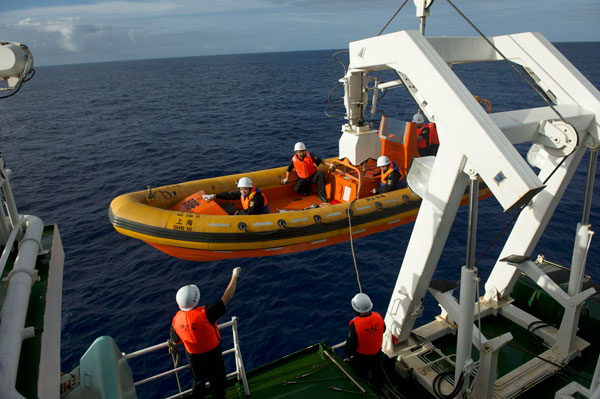Chinese ship combs new search area for jet
By Zhao Lei (China Daily) Updated: 2014-03-29 10:43
 |
|
Crew members aboard the Chinese patrol ship Haixun 01 prepare a boat equipped with black box searching devices as they search for the missing Malaysia Airlines flight MH370 in the southern Indian Ocean on Friday. Zhang Chi / for China Daily |
| Latest News | Search effort | Families' reaction | Timeline | Reporter's log |
| Infographic | Doubts | Airlines' statement | Photos | China's perspective |
 A Chinese vessel began scouring a new search area in the southern Indian Ocean on Friday in the hunt for the Malaysian Airlines jetliner.
A Chinese vessel began scouring a new search area in the southern Indian Ocean on Friday in the hunt for the Malaysian Airlines jetliner.
Seven more Chinese vessels were heading to the new area, announced by Australia, in the search for the Boeing 777-200 on flight MH370.
The Chinese patrol ship Haixun 01 arrived in the area at about 2:30 pm, the Maritime Safety Administration said.
Other ships, including the Chinese icebreaker Xuelong, naval amphibian landing crafts Kunlunshan and Jinggangshan and missile destroyer Haikou, were moving to the new area at full speed, the Ministry of Transport, which coordinates China's search operations, said in a statement.
A New Zealand Air Force Lockheed P-3 Orion spotted suspicious objects in the new search area on Friday, the Australian Maritime Safety Authority said.
But the sightings need to be confirmed by a ship, and this was not expected until Saturday, the authority said in a statement on Friday night.
Xuelong is scheduled to arrive at the center of the new area early on Sunday, said Liu Shunlin, commander-in-chief of the icebreaker's search efforts.
The deployment came as Australian search and rescue efforts switched to the new 319,000 square kilometer search area, roughly the size of Poland.
It is about four times larger than the previous area in the southern Indian Ocean and lies 1,100 km to the northeast of it, the Australian maritime authority said.
The new area is 1,850 km west of Perth, is in more moderate seas and closer to the search base so that aircraft can stay longer over it, Australian officials said at a news conference in Canberra.
Ten planes flew over the new area on Friday and the Australian naval vessel HMAS Success was expected to arrive there on Saturday, said John Young, the Australian maritime authority's emergency response general manager.
Sea depths in the new area range from 2,000 to 4,000 meters, he said.
For more than a week, ships and surveillance planes had been scouring seas 2,500 km southwest of Perth, where satellite images showed floating objects that could have been debris from the plane.
The Australian maritime authority said the change in search areas followed new information based on continuing analysis of radar data received soon after communication with the plane was lost and after it veered from its scheduled path on March 8, shortly taking off from Kuala Lumpur for Beijing.
There were 239 people on board, including 154 Chinese nationals. Malaysian Prime Minister Najib Razak said on Monday that based on satellite data the jet crashed in the southern Indian Ocean and there were no survivors.
The search area has changed several times since the plane vanished as experts analyzed a frustratingly small amount of data from the aircraft, including the radar signals and "pings" that a satellite picked up.
The latest analysis indicates the plane was traveling faster than previously estimated, resulting in increased fuel use and reducing the possible distance it could have flown before going down in the ocean.
Young said the new search area has two benefits, the first being that it is closer to Perth.
"We will certainly get better time at the scene. We started nearly 3,000 km from Perth," he said.
"The other benefit we get from being further north is the search area has moved out of the Roaring Forties, which creates very adverse weather.
"I'm not sure that we'll get perfect weather out there, but it's likely to be better more often than we've seen in the past and we will see what that does in terms of satellite imagery when the re-tasking of satellites starts to produce new material."
Xinhua and Associated Press contributed to this story.
zhaolei@chinadaily.com.cn




